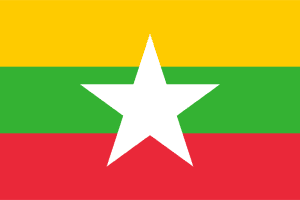
| Colors | HEX Code | RGB | CMYK |
|---|---|---|---|
| Yellow | #FECB00 | 254, 203, 0 | 0, 20, 100, 0 |
| Green | #34B233 | 52, 178, 51 | 71, 0, 71, 30 |
| White | #FFFFFF | 255, 255, 255 | 0, 0, 0, 0 |
| Red | #EA2839 | 234, 40, 57 | 0, 83, 76, 8 |
The Flag of Myanmar has three equal horizontal stripes. The top stripe is colored yellow while the middle stripe is green. The bottom stripe is red. In the center of the flag, there is a big white five-pointed star.
Meaning of the Flag of Myanmar
The yellow color stands for solidarity. The green band represents peace and tranquillity. The red color symbolizes courage and decisive action. The white star represents the country itself and the importance of the union of between different parts of the nation.
History of the Flag of Myanmar
Before the British colonization, the peacock was the symbol of Myanmar, and was featured on its flags. In 1886, the country was colonized by Britain, and its name became Burma. The peacock continued to be the symbol of Burma when the resistance movements against colonization. In 1943, Japan had established a local regime that was fought by the British and the Burmese, and the flag of the regime was yellow, green, and red with a peacock. Burma became independent in 1948. the Anti-Fascist People’s Freedom League (AFPFL), which was a political organization that played a key role in Burma’s struggle for independence, had a flag that featured a blue field with a white canton containing a large white five-pointed star and five smaller stars representing the country’s major ethnic groups. This flag became the Flag of independent Burma. In 1974, the number of small stars was increased to 14 to represent political subdivisions in the country, with a cog wheel and ears of rice. In 1988, the country’s name was changed from Burma to Myanmar, and a new constitution in 2008 led to the adoption of the yellow-green-red flag. The white star was added to the flag to replace the peacock. The current flag was officially hoisted in 2010.